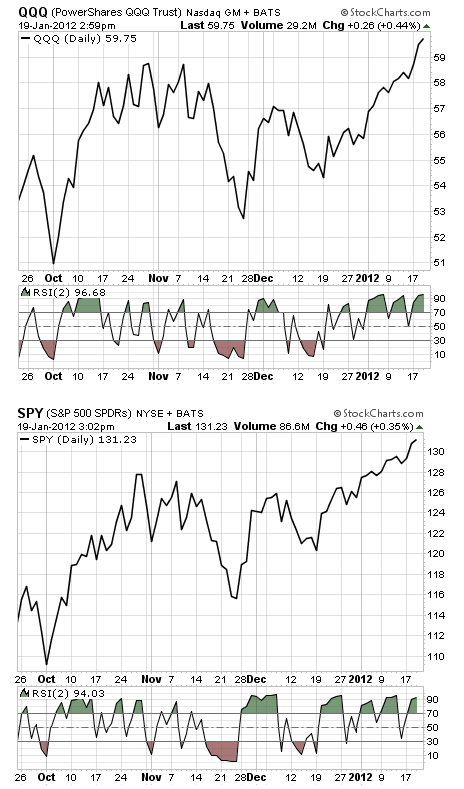The market rallied hard again yesterday, making it 10 out of 12 trading days with positive gains. SPY has advanced 4.2% during that time and a staggering 8.7% over the past month. For reference, 8.7% is typically the average ANNUAL gain for the S&P 500 – and we've seen it happen in just a month.
We're officially in crazy town.
And as expected, now we are seeing sentiment change.
But, I am not completely sold on the rally yet.
Why?
Well, almost every highly-liquid ETF I follow is overbought to very overbought. And now we're entering into the weakest period of January. Just look at the historical performance of the SPDR Dow Jones Industrial Average ETF (NYSEARCA:DIA) over the next five trading days. Looks like rough waters ahead.

Again, almost every ETF I follow is in a short-term extreme. I can't remember the last time I saw all four major market benchmarks in a very overbought state.
Just check out the overbought nature (high RSI readings) of PowerShares QQQ Trust (NASDAQ:QQQ) and SPDR S&P 500 ETF (NYSEARCA:SPY):

The decline is coming . and soon. The question is how long will it last? Will it be long enough to close the gap from January 3 or will it be another one-hit wonder. We shall all see soon enough.
I also came across an interesting article written by James Kostohryz on Seeking Alpha that mentions three handy tools for investors to identify the characteristics of a bear-market rally to avoid being lured into one. I think he is right on in his assessment. Bulls be careful. Taking a few profits off the table is never a bad thing.
How to Recognize a Bear Market Rally
1. Fundamentals: The first challenge in determining if a rally is legitimate or not is to address the fundamentals of the bear market. Are they still in play? "Stocks will often rally on relatively insignificant news during a bear market rally – news that in no way negate causes of the original decline. However, in a bear market rally, fundamental deterioration continues beneath the surface despite rising stock prices."
Given that troubles in Europe helped spark the market decline, we can say these fears still hold. In fact, the likelihood of an economic collapse in Europe seems more likely today than it did on October 4. The same can be said of America's political and budget-cutting issues.
2. Low Volume Advances: "Bear market rallies are characterized by extremely sharp advances on relatively low volume. Such advances are driven by price-indifferent purchases by short sellers, put buyers and call sellers that are aggressively executing stop-loss orders," writes Kostohryz. "Furthermore, in bear market rallies the sharpness of the price increases indicate price indifference on the part of long investors."
With regard to this element, market actions since October 4 have been sharp and on low volume.
3. Sentiment: Rallies are fueled by a reversal of pessimism and skepticism, explains Kostohryz. "Extremely bullish sentiment suggests a high probability that reasonably foreseeable positive factors are already almost entirely discounted in the price of stocks."
Most of the sentiment indicators I look at – including put/call ratios and investor polls – is showing extremes of bullishness.
I think you get the picture.
Andy Crowder
Editor and Chief Options Strategist
Options Advantage and The Strike Price
 Facebook
Facebook
 Twitter
Twitter